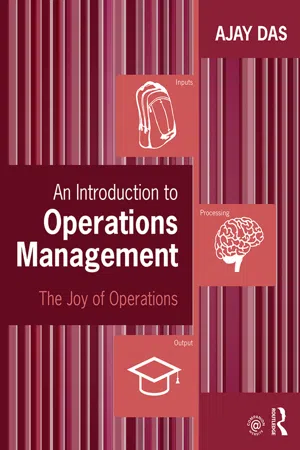
An Introduction to Operations Management
The Joy of Operations
Ajay Das
- 646 Seiten
- English
- ePUB (handyfreundlich)
- Über iOS und Android verfügbar
An Introduction to Operations Management
The Joy of Operations
Ajay Das
Über dieses Buch
An Introduction to Operations Management: The Joy of Operations covers the core topics of operations management, including product and service design, processes, capacity planning, forecasting, inventory, quality, supply chain management, and project management. Das provides a clear, connected, and current view of operations management and how it relates to a firm's strategic goals.
Students will benefit from the real-world scenarios that foster an understanding of operations management tasks. Without relying heavily on statistics and mathematical derivations, the book offers applied models and a simple, predictable chapter format to make it easy to navigate.
Students of introductory operations management courses will love this practical textbook. A companion website features an instructor's manual with test questions, as well as additional exercises and examples for in-class use.
Häufig gestellte Fragen
Information
1
Operations Management and You
- A practical understanding of the purpose and tasks of operations management
- Jobs—the benefit of studying operations management
- How to evaluate operational performance
- What’s happening now in operations management
Operations Management and You: A Road Map
Introduction
1.1 What, Exactly, Is Operations Management?
1.1.1 A Way to Think about Operations

1.1.2 What Operations Managers Do
- Exclusivity—every dress shown is different
- Affordability—a reasonable price
- Quality—good fittings and durable colors
- Availability—the dress will be there when you want it
- Service—friendly expert advice and help
- Location—right off the subway and plenty of safe parking

Every Business Makes Promises
- Toyota promises efficiency, safety, longevity, innovation: http://www.toyota.com/productleadership/
- Kia promises the “power to surprise” with “exciting and enabling” vehicles: http://www.kia.com/#/about/
- Ritz-Carlton promises to be and always be the “gold standard” in luxury hospitality: http://corporate.ritzcarlton.com/
- Motel 8 promises consistent delivery of eight features in a guest stay: http://www.super8.com/Super8/control/amenities?variant
- a) First, by building forecasting systems that attempt to anticipate variability—this, obviously, can never be perfect.
- b) Next, they try to control variability by influencing demand patterns (e.g., doctor appointments, happy hours), controlling worker variability (e.g., worker training and incentives), and managing supplier variability (e.g., information sharing, technical assistance, incentives, and penalties).
- c) Since forecasting and attempts to control variability typically offer limited results, managers build in excess capacity in the system (labor, machines, raw materials) so that peak demand can be met. This leads to waste at times of low demand and costs the business a lot.
- d) Alternatively, managers try to make their operations synch with variability by adding flexibility to work systems. Basically, they convert fixed costs into variable costs. Think of hiring temps, varying worker hours according to demand, training workers to perform different jobs, leasing equipment/hour instead of buying, and buying materials when needed instead of holding inventory. Such actions are not always possible.